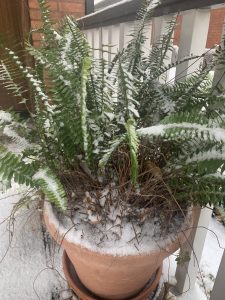
In southern Ontario, the snow came early this year. It was heavy, wet, and startlingly white against the still-golden leaves of the Ginkgo Biloba tree outside my window. The branches bowed under the unexpected weight, trembling but unbroken.

The Ginkgo is one of the last trees to lose its leaves — a patient tree that holds on, even when the world around it is ready to let go.
Watching it, I thought of how many of us are holding on right now. To routines. To relationships. To memories or roles that no longer quite fit. The weight of the world — the wars, the losses, the loneliness — feels like an early snowfall, arriving before we’ve had time to brace ourselves.
When the Season Doesn’t Match the Soul
In my therapy practice, I’ve been hearing clients say: “I just feel heavy” or “I just feel awful and I don’t know why” (moreso since we put back the clocks). For some, it’s the familiar ache of seasonal depression — the darkness settling earlier each night, the energy dropping with the temperature. For others, it’s grief: the loss of a parent, a child, a friendship, a marriage, a job, the grind of daily life, a sense of purpose.
And then there’s another kind of grief — the quieter kind that arrives when life shifts seasons. When the kids are grown, the house is still, the holidays feel different. I noticed my drive home when the snow first fell on Sunday, seeing parents pulling young kids on sleds already. On social media, one couldn’t help scrolling past photos of young families on sleds. For many people, they realize they’re in a different chapter now. The grief isn’t just for people; it’s for versions of yourself you’ve outlived. That’s big — and not really something that can just be fixed — in or out of therapy.
The Body Remembers
Science tells us that the body and brain register seasonal changes long before we consciously do. Decreasing sunlight affects serotonin, melatonin, and our circadian rhythm — but emotional memory plays its part too. The body remembers anniversaries of losses, the feeling of past winters, the loneliness of darker months. We had Thanksgiving recently. We have the festivals of light from Christmas, Chunukah and others, coming. It’s supposed to be joyful. But for many, it doesn’t feel that way.
That’s why grief isn’t solved by light therapy lamps or exercise alone. Those things help — but they don’t touch the deeper layers, the stories underneath. To move through sadness, we must be witnessed in it. Not fixed, not rushed — simply met with presence and compassion.
How Therapy Helps — Practically and Profoundly
 When we work together, I integrate multiple approaches to help you meet the heaviness in ways that are both grounding and deeply transformative. I don’t have a one size fits all approach. In our work together, we might take different paths through healing work:
When we work together, I integrate multiple approaches to help you meet the heaviness in ways that are both grounding and deeply transformative. I don’t have a one size fits all approach. In our work together, we might take different paths through healing work:
• EMDR (Eye Movement Desensitization and Reprocessing) to release stored grief and trauma that resurface during seasonal change.
• Parts Work and inner child work to meet the inner parts of you that still carry loss or resistance — the ones who learned to “stay strong” instead of soften.
• Mindfulness and Self-Compassion Practices to anchor you in your body and help you relate to pain without judgment.
• Existential and Emotionally Focused Therapy (EFT) to explore meaning, loneliness, and connection — especially in life’s later chapters.
• Grief Work to give space to sorrow, remembering, and renewal. This may involve rituals, writing, going toward grief — not avoiding it.
These modalities don’t aim to “fix” grief but to help you make contact with what is alive underneath it — love, memory, and the impulse to keep growing, even through darkness.
Wisdom for the Winter
Grief doesn’t follow the calendar (though it can feel that way). Neither does healing. The work is about learning to live alongside what hurts — to bend without breaking, to remember without drowning, to let go without forgetting, and to work on growth and expansion.
It helps to have a therapist who not only understands the clinical side of things, but who also brings lived wisdom, presence, and humility to the process. Someone who has walked through their own winters and knows that healing is less about finding answers and more about finding yourself again.
As the ginkgo eventually releases its leaves all at once — a golden shower of letting go (it actually happened the day after this 17 cm snowfall) — may we find permission to do the same. To honour what we’ve carried, to rest, to remember that bending is not breaking.
If you’re feeling the weight of this early winter — the sadness, the quiet pain of change, or the loneliness that seems to linger — reach out. Therapy can be a space to hold what’s heavy, to make meaning, and to remember that even in the coldest seasons, growth is still happening underground.
Because like the ginkgo, we are built to endure — to bend, to remember, and to begin again.
I offer in-person grief therapy to individuals, families and couples in Hamilton and surrounding area. I offer online therapy across Ontario. I treat grief, depression, anxiety, relationship issues, and more.
#seasonaldepression, #griefjourney, #winterblues, #emdrtherapy, #mindfulhealing, #ontariotherapist, #cortneypasternaktherapy, #midlifehealing, #griefsupport, #partswork, #existentialtherapy, #selfcompassion
